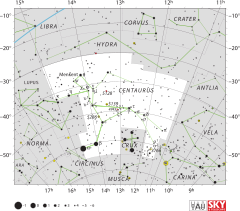| Observation data Epoch J2000.0 Equinox J2000.0 | |
|---|---|
| Constellation | Centaurus |
| Right ascension | 12h 11m 39.12805s[1] |
| Declination | −52° 22′ 06.4067″[1] |
| Apparent magnitude (V) | +3.97[2] |
| Characteristics | |
| Evolutionary stage | main sequence |
| Spectral type | B3 V[3] |
| U−B color index | −0.650[4] |
| B−V color index | −0.156±0.008[2] |
| Astrometry | |
| Radial velocity (Rv) | +15.0±4.1[5] km/s |
| Proper motion (μ) | RA: −43.741[1] mas/yr Dec.: −11.771[1] mas/yr |
| Parallax (π) | 11.8348 ± 0.3746 mas[1] |
| Distance | 276 ± 9 ly (84 ± 3 pc) |
| Absolute magnitude (MV) | −1.33[2] |
| Details | |
| Mass | 6.6±0.1[6] M☉ |
| Radius | 3.8[7] R☉ |
| Luminosity | 810.42[2] L☉ |
| Surface gravity (log g) | 3.95[8] cgs |
| Temperature | 19,500[8] K |
| Rotational velocity (v sin i) | 147[9] km/s |
| Age | 23.7±1.4[6] Myr |
| Other designations | |
| Database references | |
| SIMBAD | data |
Rho Centauri, Latinized from ρ Centauri, is a binary star[11] system in the southern constellation of Centaurus. It is visible to the naked eye as a blue-white hued point of light with a combined apparent visual magnitude of +3.97.[2] The system is located approximately 276 light years from the Sun based on parallax, and is drifting further away with a radial velocity of around +15 km/s.[5] It is a proper motion member of the Lower Centaurus–Crux sub-group in the Scorpius–Centaurus OB association, the nearest such association of co-moving massive stars to the Sun.[3]
The primary component of this system is a B-type main-sequence star with a stellar classification of B3 V.[3] It is about 24[6] million years old with a high rate of spin, showing a projected rotational velocity of 147 km/s.[9] It has 6.6[6] times the mass of the Sun and 3.8[7] times the Sun's radius. The star is radiating 810[2] times the luminosity of the Sun from its photosphere at an effective temperature of 19,500 K.[8]
The secondary companion is 1.1 magnitudes fainter than the primary, with a projected separation of 5.68 AU along a position angle of 19.72°, as of 2013.[11]
References
- ^ a b c d e Brown, A. G. A.; et al. (Gaia collaboration) (August 2018). "Gaia Data Release 2: Summary of the contents and survey properties". Astronomy & Astrophysics. 616. A1. arXiv:1804.09365. Bibcode:2018A&A...616A...1G. doi:10.1051/0004-6361/201833051. Gaia DR2 record for this source at VizieR.
- ^ a b c d e f Anderson, E.; Francis, Ch. (2012), "XHIP: An extended hipparcos compilation", Astronomy Letters, 38 (5): 331, arXiv:1108.4971, Bibcode:2012AstL...38..331A, doi:10.1134/S1063773712050015, S2CID 119257644.
- ^ a b c de Geus, E. J.; et al. (June 1989), "Physical parameters of stars in the Scorpio-Centaurus OB association", Astronomy and Astrophysics, 216 (1–2): 44–61, Bibcode:1989A&A...216...44D
- ^ Gutierrez-Moreno, Adelina; Moreno, Hugo (June 1968), "A photometric investigation of the Scorpio-Centaurus association", Astrophysical Journal Supplement, 15: 459, Bibcode:1968ApJS...15..459G, doi:10.1086/190168.
- ^ a b Gontcharov, G. A. (November 2006), "Pulkovo Compilation of Radial Velocities for 35495 Hipparcos stars in a common system", Astronomy Letters, 32 (11): 759–771, arXiv:1606.08053, Bibcode:2006AstL...32..759G, doi:10.1134/S1063773706110065, S2CID 119231169.
- ^ a b c d Tetzlaff, N.; et al. (January 2011), "A catalogue of young runaway Hipparcos stars within 3 kpc from the Sun", Monthly Notices of the Royal Astronomical Society, 410 (1): 190–200, arXiv:1007.4883, Bibcode:2011MNRAS.410..190T, doi:10.1111/j.1365-2966.2010.17434.x, S2CID 118629873
- ^ a b Pasinetti Fracassini, L. E.; et al. (February 2001), "Catalogue of Apparent Diameters and Absolute Radii of Stars (CADARS) - Third edition - Comments and statistics", Astronomy and Astrophysics, 367 (2): 521–524, arXiv:astro-ph/0012289, Bibcode:2001A&A...367..521P, doi:10.1051/0004-6361:20000451, S2CID 425754.
- ^ a b c Levenhagen, R. S.; Leister, N. V. (2006), "Spectroscopic analysis of southern B and Be stars", Monthly Notices of the Royal Astronomical Society, 371 (1): 252–262, arXiv:astro-ph/0606149, Bibcode:2006MNRAS.371..252L, doi:10.1111/j.1365-2966.2006.10655.x, S2CID 16492030.
- ^ a b Uesugi, Akira; Fukuda, Ichiro (1970), "Catalogue of rotational velocities of the stars", Contributions from the Institute of Astrophysics and Kwasan Observatory, University of Kyoto, Bibcode:1970crvs.book.....U.
- ^ "rho Cen -- Star", SIMBAD Astronomical Database, Centre de Données astronomiques de Strasbourg, retrieved 2016-12-25.
- ^ a b Rizzuto, A. C.; et al. (December 2013), "Long-baseline interferometric multiplicity survey of the Sco-Cen OB association", Monthly Notices of the Royal Astronomical Society, 436 (2): 1694–1707, arXiv:1309.3811, Bibcode:2013MNRAS.436.1694R, doi:10.1093/mnras/stt1690.

